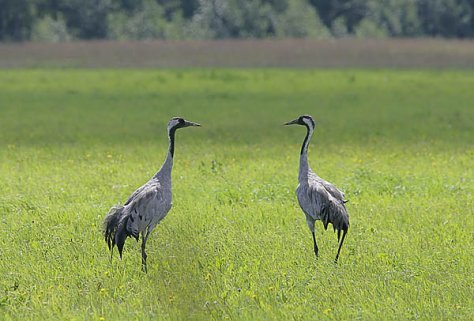Protecting the cranes
Photo: Arne Ader
Translation: Liis
Crane pair.
| Common crane |
The common crane is both a long-time native nesting species and a migrating bird in Estonia. The numbers of the species have increased greatly from the bottom level in the middle of last century, at present reaching more than 7 000 pairs. The increase has certainly been stimulated by the protection activities during the last few decades – the crane is protected by law in all countries where it nests or passes on its migration. Nearly 8 % of Europe’s cranes nest in Estonia and during the autumn migration 10% pass through and rest here.
The crane conservation plan for the period 2003-2013 has been prepared by Aivar Leito from the Institute of Agricultural and Environmental Sciences at the Estonian University of Life Sciences (EULS), and Ivar Ojaste from Keskkonnaamet (Estonian Environment Office). The Environment Office focuses primarily on the surveillance and research parts of the newly approved conservation scheme. At least four cranes will be provided with satellite transmission units, aiming in particular to locate the resting and wintering areas of birds migrating in southerly and south-easterly directions. Through PRIA and other agricultural databases the structure of arable lands will be surveyed, and changes in these areas will be followed in the crane project area. During the surveillance of the premigration gatherings of the cranes all farming land used by the birds will be mapped.
The numbers and status of cranes in the future also hinges on the global warming that may markedly reduce their nesting area, displacing it by up to 1000 km northwards at the end of the century. If this happens cranes may become an endangered species in Estonia as well as globally.
Best of luck to researchers and protectors!
.








